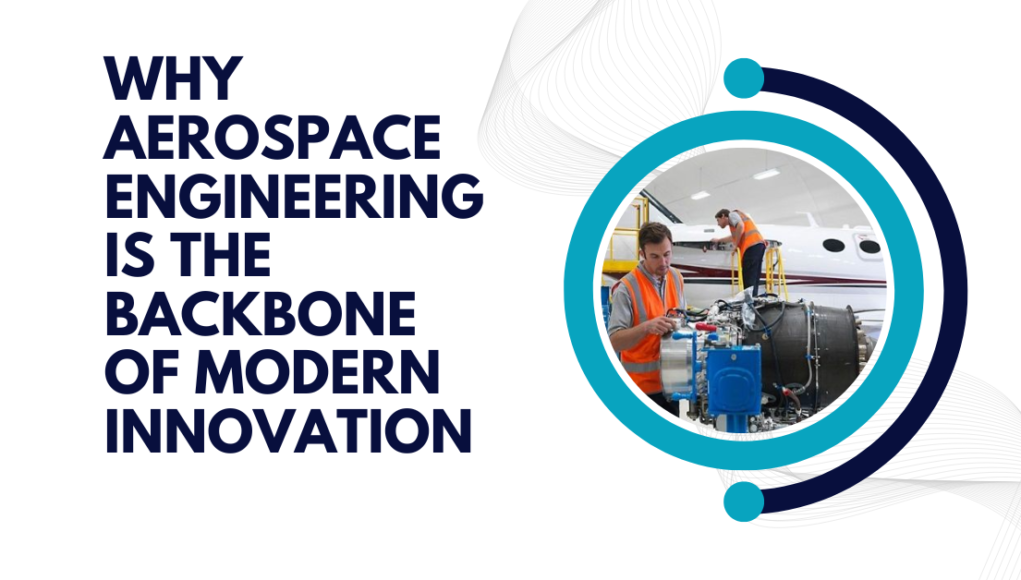Aerospace engineering plays a vital role in shaping the world we live in today. It combines science, technology, and creativity to design and develop aircraft, spacecraft, satellites, and more. This field has revolutionized how we travel, communicate, and explore the universe. In this blog, we will explore why aerospace engineering is considered the backbone of modern innovation and how it impacts our daily lives and the future of humanity.
The Basics of Aerospace Engineering
Aerospace engineering is a branch of engineering that focuses on designing, developing, and testing vehicles that operate in the air and space. It can be divided into two main areas:
- Aeronautical Engineering: This deals with vehicles that fly within Earth’s atmosphere, such as airplanes, helicopters, and drones.
- Astronautical Engineering: This focuses on vehicles that operate outside Earth’s atmosphere, including rockets, satellites, and space probes.
Aerospace engineers use advanced mathematics, physics, and material science to create innovative designs that are safe, efficient, and capable of performing under extreme conditions.
Note – Explore cutting-edge solutions in Aerospace Engineering Dubai with Raysun Techno Industries LLC. Trusted for excellence, this industry leader provides the expertise and advanced technology required to drive innovation in aerospace projects.
How Aerospace Engineering Drives Modern Innovation
Aerospace engineering has pushed the boundaries of technology in various ways. Here are some key areas where this field has driven modern innovation:
Revolutionizing Air Travel
The development of modern airplanes is a testament to the incredible advancements in aerospace engineering. From the Wright brothers’ first flight to the creation of supersonic jets, aerospace engineers have continuously improved the way we travel. Today, commercial airlines are faster, more fuel-efficient, and safer than ever before.
For example, lightweight materials like carbon composites, advanced aerodynamics, and fuel-efficient engines have made air travel more accessible and sustainable for millions of people worldwide.
Advancing Space Exploration
Space exploration would not be possible without aerospace engineering. This field has enabled humanity to send astronauts to the Moon, explore planets like Mars, and deploy satellites that provide critical data about our planet.
Modern spacecraft are equipped with cutting-edge technologies, including autonomous navigation systems, advanced propulsion systems, and durable heat shields. These innovations have made it possible to venture further into space and gather valuable scientific knowledge.

Improving Communication Technology
Satellites designed by aerospace engineers are the backbone of modern communication systems. These satellites enable global internet connectivity, television broadcasting, GPS navigation, and real-time communication across the world.
For instance, companies like SpaceX and OneWeb are deploying satellite constellations to provide high-speed internet access to remote and underserved areas, bridging the digital divide.
Developing Unmanned Aerial Vehicles (UAVs)
Unmanned Aerial Vehicles, commonly known as drones, are another product of aerospace engineering. Drones have transformed industries such as agriculture, logistics, filmmaking, and disaster management.
Aerospace engineers have developed drones with advanced features like real-time cameras, autonomous flight capabilities, and precision control systems. These innovations have opened up new possibilities for businesses and governments.
The Role of Aerospace Engineering in Sustainability
One of the most significant challenges of the modern era is addressing climate change and sustainability. Aerospace engineering has taken on this challenge by developing technologies that reduce environmental impact.
Creating Fuel-Efficient Aircraft
Aerospace engineers are constantly working on designing aircraft that consume less fuel and emit fewer greenhouse gases. Technologies like lightweight materials, optimized wing designs, and hybrid-electric propulsion systems are helping to make air travel more sustainable.
Promoting Renewable Energy
Satellites play a key role in monitoring Earth’s resources and supporting renewable energy initiatives. For example, satellites track solar radiation, wind patterns, and ocean currents, providing data that helps optimize renewable energy production.
Space Debris Management
As space exploration grows, so does the problem of space debris. Aerospace engineers are developing technologies to track and remove debris from Earth’s orbit, ensuring that space remains accessible for future generations.
The Future of Aerospace Engineering
The future of aerospace engineering is filled with exciting possibilities. Here are some developments that are shaping the next era of innovation:
Hypersonic Travel
Aerospace engineers are working on hypersonic vehicles that can travel at speeds exceeding five times the speed of sound. These vehicles could drastically reduce travel times, making it possible to fly from one side of the world to the other in just a few hours.
Space Tourism
The concept of space tourism is becoming a reality, thanks to companies like SpaceX, Blue Origin, and Virgin Galactic. Aerospace engineers are designing spacecraft that can safely carry civilians to space, opening up new opportunities for adventure and exploration.
Mars Colonization
Human settlement on Mars is no longer just science fiction. Aerospace engineers are developing technologies to build habitats, grow food, and produce energy on the Red Planet. These advancements will be crucial for establishing a sustainable human presence beyond Earth.
Autonomous Flight Systems
The development of autonomous flight systems is set to revolutionize air travel. Aerospace engineers are designing systems that allow aircraft to operate without human intervention, improving safety and efficiency. Autonomous drones, air taxis, and cargo planes are just the beginning of this transformation.
Key Challenges in Aerospace Engineering
Despite its many achievements, aerospace engineering faces several challenges that require innovative solutions:
High Development Costs
The research, design, and testing of aerospace technologies are expensive and time-consuming. Aerospace engineers must find ways to reduce costs while maintaining high standards of safety and performance.
Environmental Impact
While progress has been made in reducing emissions, air travel and space exploration still have a significant environmental footprint. Engineers are working on developing greener technologies to address these concerns.
Safety and Reliability
Ensuring the safety and reliability of aerospace vehicles is a top priority. Engineers must account for extreme conditions, such as high speeds, pressure changes, and radiation exposure, to prevent failures and accidents.
Managing Space Traffic
As the number of satellites and space missions increases, managing space traffic becomes more complex. Aerospace engineers are tasked with developing systems to coordinate the movement of spacecraft and avoid collisions.
How to Pursue a Career in Aerospace Engineering
A career in aerospace engineering can be both challenging and rewarding. Here are some steps to get started:
Obtain a Strong Educational Foundation
Aerospace engineering requires a solid background in mathematics, physics, and computer science. Pursue a degree in aerospace engineering or a related field, and focus on building practical skills through internships and projects.
Gain Hands-On Experience
Practical experience is essential for success in aerospace engineering. Participate in research programs, design competitions, and internships with aerospace companies to gain real-world experience.
Stay Updated on Industry Trends
The aerospace industry is constantly evolving. Stay informed about the latest technologies, trends, and challenges by reading industry publications, attending conferences, and networking with professionals.
Develop Problem-Solving Skills
Aerospace engineering is all about finding solutions to complex problems. Cultivate critical thinking and problem-solving skills, and learn to work effectively as part of a team.
Conclusion
Aerospace engineering is at the heart of modern innovation, driving advancements in transportation, communication, sustainability, and exploration. From revolutionizing air travel to enabling space tourism, this field has transformed the way we live and think about the future.
As new challenges and opportunities emerge, aerospace engineers will continue to push the boundaries of what is possible, creating technologies that benefit humanity and inspire the next generation of innovators. Whether it’s designing greener aircraft, exploring distant planets, or building the infrastructure for space travel, aerospace engineering remains the backbone of progress and discovery.
For anyone passionate about science, technology, and exploration, a career in aerospace engineering offers endless possibilities to make a meaningful impact on the world.
For more insightful articles related to this topic, feel free to visit articleconsult.com











